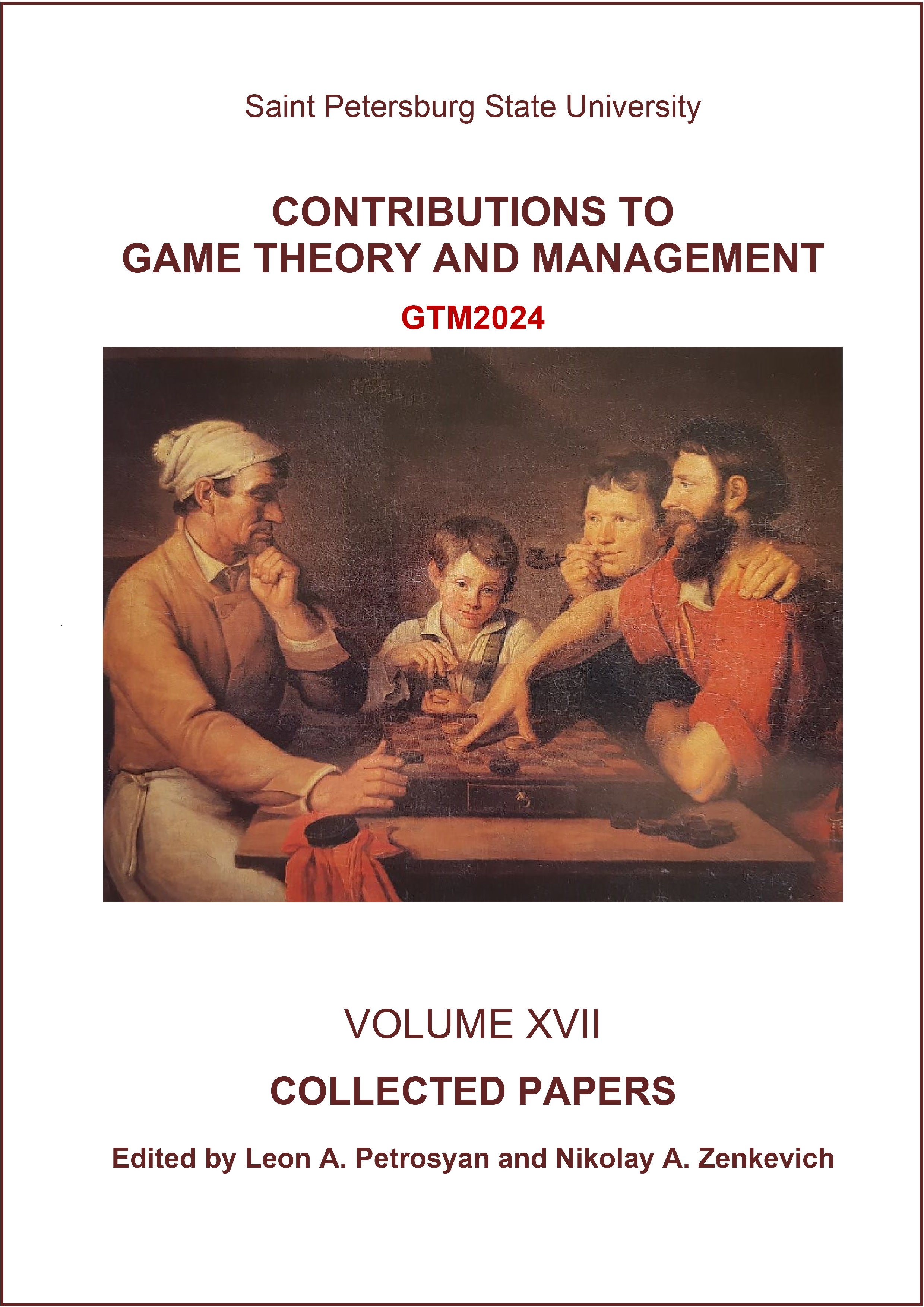Vector-Borne Malaria Epidemic Model with Vaccination
Abstract
This paper presents the dynamic epidemic model of the direct transmission of the vector-host type. The malaria distribution model is determined by a system of ordinary differential equations. The host population is divided into four subpopulations: susceptible, exposed, infected, and recovered, and the vector population is divided into three subpopulations: susceptible, exposed, and infected. Using the theory of Lyapunov functions, certain sufficient conditions are achieved for the stability of the disease-free equilibrium and endemic equilibrium. The basic reproductive number R0 has been found, it characterizes the epidemic development in the population. The part of the human population is vaccinated and we examine how this prevents the development of mosquitoes in the vector population. Finally, numerical modeling is carried out to study the influence of key parameters on the spread of vector-borne diseases.
Keywords:
malaria, vector-host epidemic model, numerical modeling, host population, vector population, subpopulations, reproductive number, diseasefree equilibrium, endemic equilibrium
Downloads
References
Aldila, D., Seno, H. A. (2019). Population dynamics model of mosquito-borne disease transmission, focusing on mosquitoes biased distribution and mosquito repellent use Bull. Math. Biol, 81, 4977–5008.
Atcheson, E., Bauza, K., Reyes-Sandoval, A. (2019) A probabilistic model of pre-erythrocytic malaria vaccine combination in mice. PLoS ONE, 14(1): e0209028
Bernoulli, D. (1760). Essai dune nouvelle analyse de la mortalité causée par la petite vérole et des avantages de linoculation pour la prévenir. Hist. Acad. R. Sci. Paris (Paris) 1–45 (1760/1766).
Britton, T. (2010). Stochastic epidemic models: A survey. Mathematical Biosciences, 225(1), 24–35.
Calistus, N. Ng. (2022). The impact of temperature and decay in insecticide-treated net efficacy on malaria prevalence and control. Mathematical Biosciences, 355, https://doi.org/10.1016/j.mbs.2022.108936
Challenger, J. D., Olivera Mesa, D., Da, D. F., Yerbanga, R. S., Lefévre, T., Cohuet, A., Churcher, T. S. (2021). Predicting the public health impact of a malaria transmission-blocking vaccine. Nature Communication, 12(1494), 1–12.
Chander, P., Tulkens, H. (1997). The core of an economy with multilateral environmental externalities. International Journal of Game Theory, 26, 379–401.
Chang, S. L., Piraveenan, M., Pattison, P., Prokopenko, M. (2020). Game theoretic modelling of infectious disease dynamics and intervention methods. Journal of Biological Dynamic, 14(1), 57–89. https://doi.org/10.1080/17513758.2020.1720322
Cooper, I., Mondal, A., Antonopoulos, C. G. (2020). A SIR model assumption for the spread of COVID-19 in different communities. Chaos Solitons Fractals 139(110057).
Diekmann, O., Heesterbeek, A. P., Roberts, M. G. (2010). The construction of next-generation matrices for compartmental epidemic models. J. R. Soc. Interface, 7, 873–885.
Dietz, K., Heesterbeek, J. A. P. (2002). Daniel bernoulli s epidemiological model revisited. Mathematical Biosciences, 1–21.
Forouzannia, F., Gumel, A. B. (2014). Mathematical analysis of an agestructured model for malaria transmission dynamics. Mathematical Biosciences, 247, 80–94.
Forouzannia, F., Gumel, A. B. (2015). Dynamics of an age-structured two-strain model for malaria transmission. Applied Mathematics and Computation, 250, 860–886.
Galactionova, K., Smith, T. A., Penny, M. A. (2021). Insights from modelling malaria vaccines for policy decisions: the focus on RTS,S. Malaria Journal, 20(1), 1–8.
Herdicho, F. F., Chukwu Williams, Tasman, H. (2021). An optimal control of malaria transmission model with mosquito seasonal factor. Results in Physics, 25(104238).
Jia Li. (2013). Simple discrete-time malarial models. Journal of Difference Equations and Applications, 19(4), 649–666,
Jones, J. H. (2007). Notes on R0. Department of Anthropological Sciences. Stanford, CA, USA, 323, 1–19.
Kermack, W. O., McKendrick, A. G. (1927). A contribution to the mathematical theory of epidemics. Proceedings of the Royal Society of London. Series A, 115(772), 700–721.
Koella, J. C. (1991). On the use of mathematical models of malaria transmission. Acta Tropica, 49(1), 1–25.
Labadin, J., Kong, C. M. L., Juang, S. F. S. (2009). Deterministic Malaria Transmission Model with Acquired Immunity. Proceedings of the World Congress on Engeneering and Computer Science, II, WCECS, 20–22, San Francisco, USA.
Lipsitch, M., Cohen, T., Cooper, B., Robins, J. M., Ma, S., James, L., Gopalakrishna, G., Chew, S. K., Tan, C. C., Samore, M. H., Fisman, D., Murray, M. (2003). Transmission dynamics and control of severe acute respiratory syndrome. Science, 300, 1966–1970.
Nakul, C., Cushing, J. M., Hyman, J. M. (2006). Bifurcation analysis of a mathematical model for malaria transmission. SIAM Journal on Applied Mathematics, 67(1), 24–25.
Ndiaye, S. M. (2022). Vector epidemic model of malaria with non constant-size population. Contributions to Game Theory and Management, 15, 200–217. https://doi.org/10.21638/11701/spbu31.2022.15
Ndiaye, S. M. and Parilina, E. M. (2022). An epidemic model of malaria without and with vaccination. Pt 1. A model of malaria without vaccination. Vestnik of Saint Petersburg University. Applied Mathematics. Computer Science. Control Processes, 18(2), 263–277 (in Russian).
Niare, S., Berenger, J. M., Dieme, C., Doumbo, O., Raoult, D., Parola, P., Almeras, L. (2016). Identification of blood meal sources in the main african malaria mosquito vector by maldi-tof ms. Malaria journal, 15(87) 15, 1–15.
Smith, D. L., Battle, K. E., Hay, S. I., Barker, C. M., Scott, T. W. (2021). Ross, Macdonald, and a Theory for the Dynamics and Control of Mosquito-Transmitted Pathogens. PLoS Pathog, 8(4) : e1002588. https://doi.org/10.1371/journal.ppat.1002588
Smith, T., Killeen, G. F., Maire, N., Ross, A., Molineaux, L., Tediosi, F., Hutton, G., Utzinger, J., Dietz, K., Tanner, M. (2006). Mathematical modeling of the impact of malaria vaccines on the clinical epidemiology and natural history of plasmodium falciparum malaria: Overview. The American Journal of Tropical Medicine and Hygiene, 75, Issue 2-suppl., 1–10.
Takashima, E., Tachibana, M., Morita, M., Nagaoka, H., Kanoi, B. N., Tsuboi, T. (2021). Identification of novel malaria transmissionblocking vaccine candidates. Front Cell Infect Microbiol, 2(1224).
Teboh-Ewungkem, M. I., Podder, C. N., Gumel, A. B. (2010). Mathematical study of the role of gametocytes and an imperfect vaccine on malaria transmission dynamics. Bulletin of Mathematical Biology, 72(1), 63–93.
Van den Driessche P. (2017). Reproduction numbers of infectious disease models. Infect. Dis. Model, 2, 288–303.
WHO (2021) World Malaria Report. https://www.who.int/teams/global-malaria-programme/reports/world-malaria-report-2021
WHO (2024). Roll Back Malaria, www.rollbackmalaria.org
Downloads
Published
How to Cite
Issue
Section
License
Articles of "Contributions to Game Theory and Management" are open access distributed under the terms of the License Agreement with Saint Petersburg State University, which permits to the authors unrestricted distribution and self-archiving free of charge.




